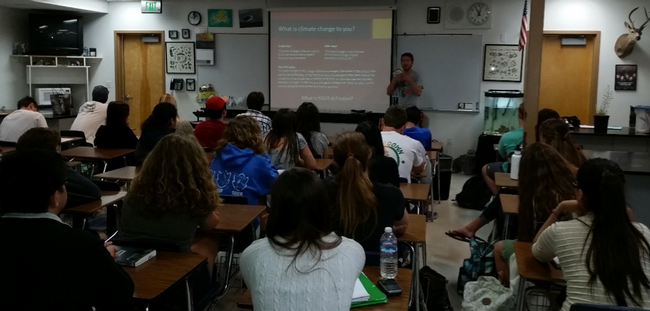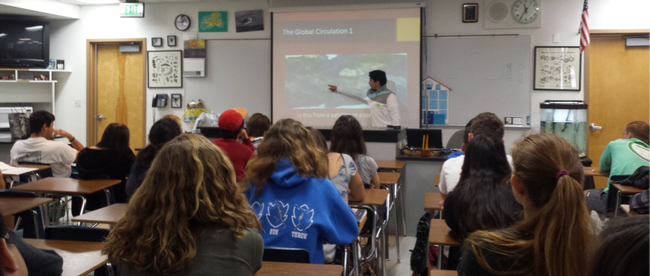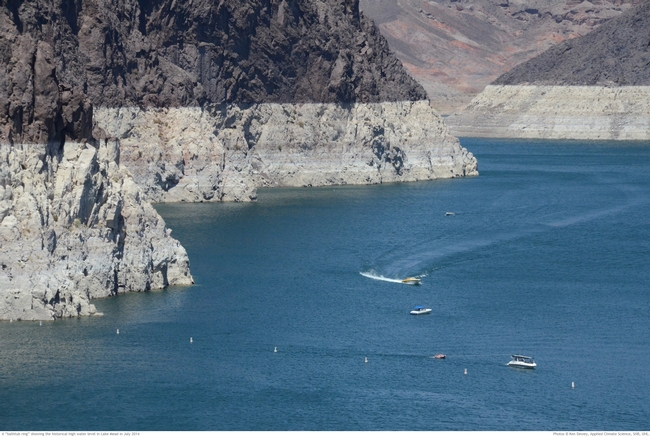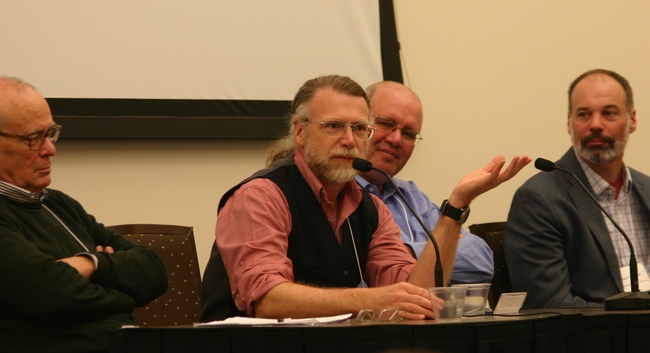- Author: Carole Hom
UC Davis hydrogeologist and CCWAS IGERT PI Graham Fogg appeared on Capital Public Radio's Insight program to discuss levee setback, floodplains, and groundwater recharge on the Cosumnes River. According to Fogg, groundwater has the potential to store at least as much water as California's four largest reservoirs combined. Moving levees back to increase floodplain extent can recharge groundwater stores, which will increase future water supplies while providing environmental benefits.
- Author: Jorge Guerra
When is the best time to educate people about climate and their function within our environment? I would say that every time is a good time! My colleague Josephine Fong recently posted on her experience with middle school students, and here I will tell you about our experience with a group of high school students in Eric Bastin's Environmental Science classes at Davis High School. Alan Rhoades and I (Jorge Guerra) had the pleasure to present an overview of climate change to these students from the perspective of the fundamental science and our individual and societal roles.
| Our presentation started by challenging ourselves and the students to define climate change. We began by discussing a common definition of climate change provided by the Intergovernmental Panel on Climate Change (IPCC): |  Alan Rhoades leads a discussion of definitions of climate change. |
“Climate change in IPCC usage refers to a change in the state of the climate that can be identified (e.g. using statistical tests) by changes in the mean and/or the variability of its properties, and that persists for an extended period, typically decades or longer. It refers to any change in climate over time, whether due to natural variability or as a result of human activity.”
Given what the IPCC formally defines as climate change, Alan and I took some time to contrast this with our personal definitions and those of the students. This exercise allows an individual to reflect on how all of us intuitively understand climate change. The students provided their thoughts reflecting what is most important to them when they think of climate change. These were specific events that have been linked to climate change such as: drought, polar bears, melting ice sheets, etc. While Alan and I sought to construct more general definitions based on our experience, it is clear that what we show below differs significantly from what theIPCC gives us, even for a pair of young climate scientists!
It is important to emphasize that climate change as a consequence of human activity is a phenomenon subject to serious scrutiny and one that has gained a broad consensus in the scientific community.
With an emphasis on the process that the IPCC has established in their assessments since 1988, our presentation moved to discuss some of the techniques used to understand climate change. We started exploring data and information on temperature, sea ice extent, CO2 concentration, spring snowpack, and ocean acidification by juxtaposing technical figures with images of places and situations affected by these changes. We followed this with an overview of radiation transfer in the atmosphere and how this process leads to an elevated global averaged surface temperature, the basis for the so-called “Greenhouse Effect”.
The subject of radiation poses a challenge to early education on climate change. Alan and I used analogy, metaphor, and as many hand gestures as we could imagine to convey the ideas of radiation, physical chemistry, and ultimately how these translate into an imbalanced energy input to the atmosphere. We also touched on some of the proxies used to derive climate observations such as tree rings, ice cores, sediment cores, etc. One objective of the presentation was to show students the diversity of disciplines necessary to study climate change.
| After discussing the fundamentals of climate change and how climate is observed, we introduced climate models as tools to conduct virtual experiments on a global scale in the absence of a planet wide laboratory. We focused on the processes and components included in a model, and described the computing resources needed for computations. |  Atmospheric scientists, such as Jorge Guerra, use computer models to study climate. These models provide a means to experiment with variables that may influence global patterns of climate. |
We showed two animations of the general circulation; one from satellite data, and one from model data. When asked to tell them apart, the students (by show of hands) gave about an even split! One student commented that she was able to guess the model data correctly because it didn't look “random enough” and that the satellite loop was more “realistic.” Indeed, she touched on sophisticated problem in the construction of models: how to reproduce the true statistical properties of the real atmosphere in a model that operates over a truncated range of scales.
Lastly, we showed data on the production of CO2 globally by country and per-capita for countries with the highest output. Unfortunately, that message is not positive for citizens of industrialized nations, but it also conveys hope in the role of personal responsibility. An important goal of the presentation was to leave students certain that their individual choices do indeed matter and scale up to communities and into the world. In this sense, they were already well versed on some of the well-known alternatives that reduce CO2 waste. In thinking about climate change, the students are eager for solutions and they persistently asked “is it too late?” The answer is no, it is never too late to become diligent stewards of our environment and secure a healthy future for all life on Earth.
- Author: Stephen Maples
California has endured another winter of exceedingly low statewide precipitation on the heels of the 2013-14 record-breaking drought. The Sierras have accumulated a meager snowpack that is the lowest in recorded history. Mandatory statewide water restrictions have been implemented for the first time. Agricultural water diversions from state and federal water projects are projected to be 20% and 0% of normal, respectively. Residents, businesses, and policymakers in California and other western states are now scrambling to adapt with this ‘unprecedented' water scarcity.
|
Suggestions for solutions have been diverse, ranging from timid to outlandish. William Shatner has proposed a $30 billon Kickstarter campaign to build a pipeline from Seattle to California. And although California has received the majority of media coverage, it's not alone in this crisis. Nevada farmers in Mason and Smith Valleys are contending with a 50% across-the-board cut in groundwater pumping, and Lake Mead dropped to the lowest recorded level in history just this week. |
 Lake Mead in July, 2014. Ken Dewey/NOAA |
Never to let a good crisis go to waste, the 2014 cohort of CCWAS IGERT students held their annual conference—“Water Scarcity in the West: Past, Present, and Future”—amidst increasingly contentious discussions in the media about how the Western US is going to weather its water woes. Our two-day conference (April 6-7th) brought together a diverse group of experts to discuss the current drought within the broader context of water scarcity in the Western US.
The first day included a poster session of water-scarcity related research conducted by UC Davis and Colorado School of Mines students, a photo series documenting the drought's impacts on Central Valley communities by Matt Black, and a keynote presentation by John Laird, the California Secretary of Natural Resources.
| The second day comprised a full day of talks and panel discussions from twelve invited speakers. The focus was to (1) characterize past, present, and future water scarcity in the west, and (2) highlight methods for coping with water scarcity from a variety of sectors. Experts weighed in from a wide range of perspectives, including agriculture, atmospheric science, economics, geography, history, hydrology, and policy sectors. |
 A panel with Richard Walker, Mark Fiege, Ken Tate, and Reed Maxwell. |
Given the diversity of voices participating in the conference, the CCWAS students were especially interested in gaining insight from all speakers on three driving questions related to water scarcity:
- Which sectors or groups will be most impacted if our future is characterized by less water?
- Is there a social responsibility to mitigate these impacts? Where does this responsibility lie?
- Is increased water scarcity the “new normal”?
Responses to these questions highlighted areas of consensus across disciplines and, indeed, some disparities.
Nearly all speakers noted that impoverished and underrepresented communities will likely suffer disproportionately under increasing water scarcity:
Poor, urban residents in the large urbanized areas in underdeveloped countries. Because they have the lowest resources, the lowest position of power and traditionally they have the highest cost of water too because they're not connected to a system.
— Richard Howitt
Agriculture and farm workers in particular. Anybody who's involved in agriculture production, downstream activities like food processing, trucking, all those ancillary industries.
— David Sunding
Some speakers noted that the most vulnerable communities are non human groups and the people who rely upon them:
… [I]t's the native fish and the fishermen who will be among the most affected because the development of water in CA has already created essentially a perpetual drought for native fish, salmon and so forth, and as you get into real droughts beyond that and additional demands of water for increased populations, and so forth, the environmental water is always the first to be sacrificed.
—Peter Moyle
All speakers agreed that there is a social responsibility to mitigate the impacts of water scarcity on these groups. Many agreed that the responsibility should be shared:
It's a complicated social responsibility because it's an individual responsibility from the individual user all the way up through the various agencies, the state, and at the end of the day also for the federal government. I think it is irresponsible to not start talking about, use this as a learning lesson, what could we have done differently, where did we miss those opportunities. So yes, I think we do. We owe it to the people who live in the Western US.
— Pat Mulroy
I do feel like we have a responsibility, to take care of society as a whole … I'd prefer if it was done on a community level. I think that in California, it seems like that some communities respond really well and take care. But then when it's across communities, you do see some real disparities.
— Frances Malamud-Roam
To me, the responses to the third question were the most diverse. Many agreed that the science suggests that these drought conditions may be a harbinger of the ‘new normal' in a warmer future climate:
One of my colleagues describes [the atmosphere] as a giant vacuum cleaner in the sky that sucks water out of the ground ... if it's warmer, it's going to want more water, and that's a really big important piece even if all other things stay the same. That means that the amount of water going into the terrestrial system, going into streams, going into groundwater, going to lakes, going into surface and subsurface stores, it's going to be less.
— Reed Maxwell
Others noted that perhaps we should take a step back to remind ourselves that the current drought will eventually break:
I remind people, it will rain again. The drought is not going to last forever, we've been through periods like this before. In fact, by some measures, this isn't even the worst drought that we've had in California like in my lifetime. The '76-'77 drought was short, but more severe by many measures than what we're experiencing right now.
— David Sunding
Certainly this drought could be a preview of what's to come, but others pointed out that the bigger picture is more nuanced. Although water scarcity and drought are interrelated, we should be careful not to conflate the two.
From the climate perspective, [increased water scarcity is] probably not [the new norm]; from the consumer perspective, probably. I think what it is, is climate is highly variable, and on very long time scales you can have these mega droughts and mega pluvials where you have unusual wetness and unusual dryness … you know, you're not going to move Arizona now and plant a yard of grass. You are going to use xerophytic landscaping to make sure that you are not overusing water. But people are still moving to Arizona, they're moving to California, they're moving to Nevada, somewhat, and Utah, and all these places that are dry.
— David Easterling
Scarcity is a relative term, it's relative to how much we use so there's how much is available in the natural system but the other critically important part of that balance is how much are we using, when are we using it, how are we using it.
—Daniel Swain
A consistent line of thought seems to be that we've created a regime where human-induced scarcity is the big player that we must grapple with, regardless of the current drought.
For me, the biggest take home message seemed to be that each of these disciplines provides an important but incomplete depiction of the state of the science. The knowledge base is a patchwork, and conferences like this are a step in the right direction, helping to bridge gaps for interdisciplinary research and provide new avenues for scientific communication.
An upside of the drought may be that it is fostering discussions among scientists, policymakers, and laypeople alike about the future of water scarcity in the west. What is the ‘new normal' that we should be preparing for? Are we in it? Or should we be preparing for something else?
- Author: Carole Hom
Check out today's post on the California Water Blog by CCWAS trainers Josh Viers and Graham Fogg: drought, flood protection, floodplains, and groundwater recharge.

- Author: James Gilbert
We've all heard, time and again, that California farmers produce about half of this country's fruits and vegetables. The recent drought has focused attention and scrutiny on all aspects of water use in California, including agriculture. The result often plays out as news stories pitting growing urban water needs against farmers who defend their efficiency gains and crucial contribution to the country's food system (here's an example). Implicit in many of these discussions, however, is the idea that taking water away from California farmers necessarily imperils fruit and vegetable production, that a shift of water supply to urban consumers means things like fewer strawberries and tomatoes. Is that really the case though? Where does all of that irrigation water end up?
It turns out California irrigation water is just as likely to end up as cheese on your pizza as it is to be an onion or a watermelon.
In recent history, agricultural activities have accounted for about 80% of the total net water use. The term ‘net water use' commonly refers to the amount of water that is lost from the system – by transport or degradation - as a result of some activity. In agriculture, this includes loss by evapotranspiration (a so-called ‘consumptive' use) or contamination by soil salts.
With so much attention paid to the fruits and vegetables California farmers produce, one might expect the breakdown of agricultural water use in the state to be dominated by those sectors. However, data reported by the California Department of Water Resources (DWR) for 2010 suggest otherwise.
Pasture: Clover, mixed pasture, native pastures, induced high water table native pasture, miscellaneous grasses, turf farms, bermuda grass, rye grass and klein grass
Fruits: Apples, apricots, cherries, peaches, nectarines, pears, plums, prunes, figs, walnuts and miscellaneous deciduous; Grapefruit, lemons, oranges, dates, avocados, olives, kiwis, jojoba, eucalyptus and miscellaneous subtropical fruit; Table grapes, wine grapes and raisin grapes
Grains: Wheat, barley, oats, miscellaneous grain and hay, and mixed grain and hay; Rice and wild rice; Flax, hops, grain sorghum, sudan, castor beans, miscellaneous fields, sunflowers, hybrid sorghum / sudan, millet and sugar cane; Corn (field and sweet)
Vegetables: Tomatoes for processing & market; Melons, squash and cucumbers; Onions and garlic; Potatoes; Artichokes, asparagus, beans (green), carrots, celery, lettuce, peas, spinach, flowers nursery and tree farms, bush berries, strawberries, peppers, broccoli, cabbage, cauliflower and brussel sprouts
Other: Cotton; Sugar beets; dry beans, safflower
The data show that a large portion of the water evapotranspired by crops – i.e. water consumptively used in the process of growing the crop – goes not to fruits and vegetables but rather to alfalfa, pasture, and grains. In fact, the combined 30% of water used to grow fruits and vegetables is roughly equal to the 28% of water use going to alfalfa and pasture alone.
So if one out of every four gallons of water consumptively used by agriculture in California goes to forages like alfalfa, where do those forages go?
While some California alfalfa does get shipped across the country and even across the Pacific to China, roughly 75% of the alfalfa produced in California stays in the state to feed dairy cattle [1]. The ready supply of high quality forages has been one of the reasons California is now the leading producer of milk in the United States, responsible for ~20% of the national production in 2013 [2]. Increasingly, that raw milk is ending up as cheese, and more often than not that cheese is mozzarella. In 2012 about 43% of raw milk was used for cheese [3]. Mozzarella and ‘other Italian' cheeses accounted for 42% of the cheese produced from that milk. If we assume that all this cheese ends up on pizza and do some back-of-the-envelope calculations based on these estimates*, we se that a little less than 1 in every 100 gallons (0.8 %) used by crops in California ends up going to the cheese on top of your pizza. For reference, that's roughly the same amount that goes to onions, melons, or tomatoes, according to the 2010 DWR data.
This exercise in tracking agricultural water use to consumers is interesting, but doesn't necessarily lead to a meaningful conclusion on its own. Rather, it points to ideas worth contemplating in the context of water use, management and our food. First, the conversion of irrigation water to pizza cheese highlights the ‘virtual water' that gets shipped out of California in various foods and products. Second, and perhaps more importantly, the current agricultural water use configuration in California, at least in aggregate, could accommodate shifts in allocation to different farm and urban sectors without endangering fruit and nut production. Such a shift would rely on reduced alfalfa and/or dairy production, a trend that may already be underway [4,5].
*These calculations are greatly simplified and do not take into account any other uses of water along the production chain other than that needed to grow the original alfalfa feedstock.
[1] Putnam D.H., Summers C.G., Orloff S.B.. 2007. Alfalfa Production Systems in California. Publication 8287. Oakland, CA: Division of Agriculture and Natural Resources, University of California.
[2] “USDA Economic Research Service - Dairy Data.” 2015. Accessed March 2. http://www.ers.usda.gov/data-products/dairy-data.aspx.
[3] 2012 Dairy Products Utilization & Production Trends. 2013. American Dairy Products Institute.
[4] “California Dairies Look to Midwest's Greener Pastures | Harvest Public Media.” 2015. Accessed March 2. http://harvestpublicmedia.org/article/california-dairies-look- midwest%E2%80%99s-greener-pastures.
[5] Harrington, Lisa M. B., Max Lu, and David E. Kromm. 2010. “Milking the Plains: Movement of Large Dairy Operations into Southwestern Kansas.” The Geographical Review 100 (4): 538.







